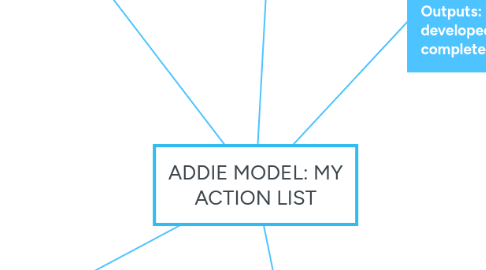
1. 1. Analysis Outputs: Training Goal defined with client and Learning Objectives aligned with learners needs
1.1. 1. Instructional Goal (Understand the need of the client by speaking with them)
1.2. 2. Learner analysis (Define who they are, what their current knowledge is, current levels of motivation, level/amount of content needed, pre-requisites/resources required)
1.3. 3. Instructional Analysis (Develop the instructional steps and sub-steps)
1.4. 4.Learning Objectives (List the new skills, knowledge, attitudes of the learners . Use strong verbs: explain, report, describe, list, demonstrate, compare, calculate, analyse, show)
1.5. 5. Evaluate clarity by talking a colleague through the logic of my goals and objectives
2. 5. Evaluation Outputs: Formative Evaluation completed throughout, Summative Report delivered to the client
2.1. 1. Formative Evaluation (is done throughout, not just at the end, prepare assessment questions ahead of time) Dick and Carey: Clarity, Impact, Feasibility
2.1.1. a. One-To-One (conduct structured interview to gain feedback)
2.1.2. b. Small group (test changes from 1:1 and assess group feasibility) Potentially not applicable to this project, but includes questions covering: interest, understanding, relatable, enough practice, did the test measure your knowledge, enough feedback, etc
2.1.3. c. field trial (conduct real-time rehearsal in similar setting - potential to test some of the sample int he online environment)
2.2. 2. Summative Evaluation (prove the worth of the learning)
2.2.1. Kirkpatricks evaluation model
2.2.2. a. Reaction (create anonymous likert scale against statements plus open ended on strengths and weaknesses)
2.2.3. b. Learning (develop post-test achievement via multiple choice test, skills via performance test, attitudes via questionnaire)
2.2.4. c. Behaviour (transfer of training to real-life such as through observation, for this project I'd create a self report checklist sent via email 2 weeks after end of course )
2.2.5. d. Results (potentially tricky for this project, can include collecting pre and post qualitative data where possible: profits, morale, job satisfaction, productivity)
3. 2. Design Outputs: Training Plan developed
3.1. 1. Design Assessments (Decide how will the learners be tested remembering the online constraint)
3.2. Dick and Carey - get the right fit for goals/performance objectives, learners, context and assessment. Make it as close to real-life as possible.
3.3. 2. Choose the course format (decide on presentation medium - this project will be online)
3.4. 3. Create Instructional Strategy (create lectures, readings, discussions, projects, worksheets, assessments, quizzes) Objectives, sequence and materials within the lesson will also be decided
3.4.1. a. Pre-instructional activities (to motivate and outline objectives for the learners)
3.4.2. b. Content presentation (concise information within worksheets, instructions, or presentations that include lots of examples)
3.4.3. c. Learner participation (decide how enabling practice and feedback will be incorporated in the online environment)
3.4.4. d. Assessment (create practice assessment and attitude/confidence quiz)
3.4.5. e. Decide on follow up activities to internalise learning post-course
3.5. 4. Evaluate Training Plan by gaining feedback from EdX classmates - perhaps ask a single question focussed on Clarity, Feasibility and Impact
4. 3. Development Outputs: Training Materials developed and run-through completed
4.1. 1. Create a sample (showing client examples of readings, instructions, videos, worksheets and assessments)
4.2. 2. Develop the course materials (develop the sample materials into drafts, keeping in mind the feedback from the client). Review with the client.
4.3. 3.Conduct a run-through (real-time rehearsal using all materials with friend or colleague) Including testing in-lesson learner feedback approaches and formative feedback sheet ahead of time to gain structured input from learner - focus on clarity and feasibility.
4.3.1. 1. Train the instructor (make sure they understand the objectives, activities, media, assessments - not applicable for this project but important to remember)
